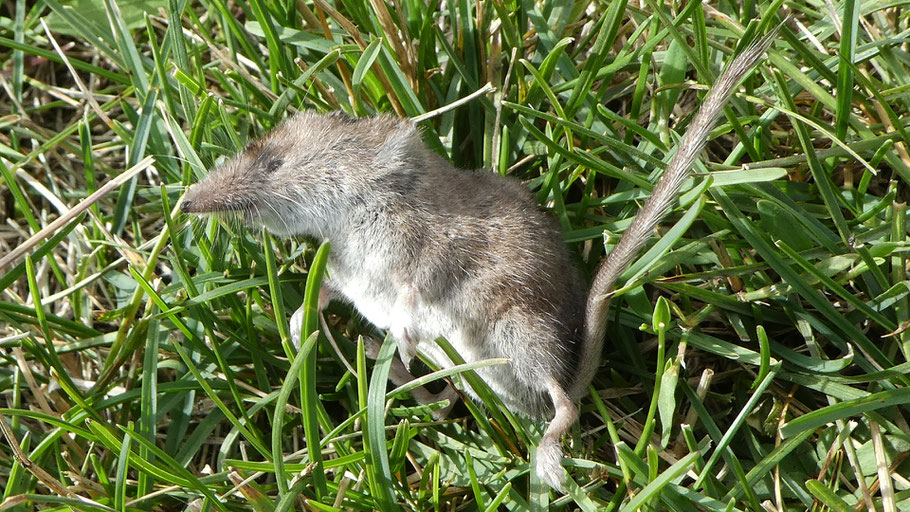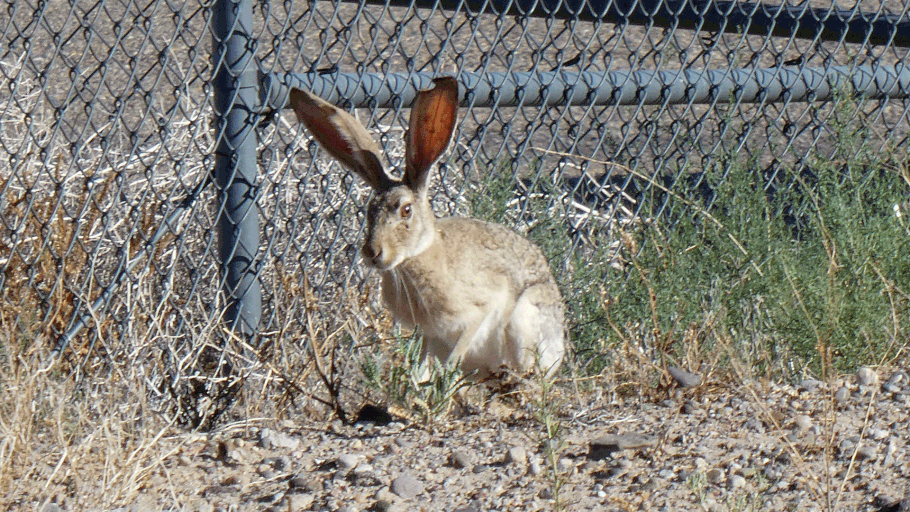A few New Mexico mammals
As of August 2019, a new section. As images appear, they'll be arranged in alphabetical order by taxon. The exception is the porcupines of the Rio Grande Bosque, which get their own page.
Please don't take my IDs as authoritative. These pages of nature photos represent one person's voyage of discovery, not the studies of a trained expert. If you see something I've misidentified, please contact me via my "Contact" page, which is tabbed at the top.
Artiodactyla
Antilocapridae: Pronghorn (Antilocapra americana)
Photos taken at extreme camera range, of an animal that's understandably wary of humans.
Bovidae: Plains Bison (Bison bison bison)
At one time, North America's bison combined numbered over 25 million. By 1880, there were fewer than 600. Today there are multiple small herds of plains bison in New Mexico, but none is free-roaming. One herd is maintained by Sandia Pueblo—not surprising, given the bison's significance to the Pueblos. To get these pictures, I had to stand behind one fence and aim my camera through another. The residences in the background are just off Sandia land, at the north edge of Albuquerque.
The first time I wrote this comment, I stated that "one herd belongs to" Sandia Pueblo. However, that was imposing the Euroamerican concept of ownership.
Cervidae: Mule Deer (Odocoileus hemionus)
It's common to see mule deer in the Sandias, but they also range into Albuquerque's easternmost neighborhoods. In September 2021 I watched a doe graze on someone's landscaping in a built-up area. She was skinny, so probably driven into the "burbs" by hunger. To see a video of mule deer grazing on cholla fruit, at a time when few other foods are available, click here.
Tayassuidae: Collared Peccary (Dicotyles tajacu)
Here's a critter I never expected to see ambling through central New Mexico. Since taking the photos, however, I've learned that they're expanding their range. Historically, they stayed in the southwest corner of the state. In the U.S. they're almost universally known as javelinas, but that name applies to several New World species. If you see a javelina anywhere in New Mexico, it's Dicotyles tajacu, the collared peccary.
Carnivora
Canidae: Coyote (Canis latrans)
Max Evans is no longer with us—he died in August 2020—but in October of that year I found a coyote in his back yard. How appropriate. The coyote was unafraid of me, but wasn't threatening either. A few months later I found the same coyote (sometimes called the Ridgecrest Coyote) in the same yard, enjoying a bit of sun. I often encounter coyotes in other places, including down in the Bosque. You can see my YouTube videos of coyotes by clicking here and here.
Canidae: Gray Fox (Urocyon cinereoargenteus)
I've yet to come up with a fox photograph of my own, but a grandson provided me with a couple of cell phone pictures of a gray fox in an Albuquerque back yard. (Photo credits: Duncan Gardner. Used by permission.) To see a video clip of two foxes in the same yard at night, click here.
Procyonidae: Raccoon (Procyon lotor)
In Albuquerque, as in so many other places, raccoons are a pest. Handsome creatures, though. The low-light photo from October 2020 show a raccoon raiding food my wife and I set out for birds and ground squirrels. In the June 2021 photo of tracks, you can see a print from a hind paw on the left and a print from a front paw on the right. In April 2023 a fellow visitor to the Rio Grande Nature Center pointed out a pair of raccoons sleeping in a tree. I got pictures of one raccoon's body and face, but its partner never showed more than a ball of fur.
Ursidae: Black Bear (Ursus americanus)
To see my YouTube video of these bears, click here.
Chiroptera
Molossidae? Free-Tailed Bat?
In May 2021 I was surprised to see a bat flying in broad daylight. It kept diving through a cloud of tiny insects that had formed over an irrigation drain. At times it plucked insects off the surface of the water. The pictures are the best I could do. A mammologist I know looked at them, and thinks that they may be of a free-tailed bat (Molossidae), possibly a Mexican Free-Tailed Bat (Tadarida brasiliensis). He informed me that while daytime feeding is unusual, it does happen, especially if a bat is disturbed out of its sleep.
Eulipotyphla
Soricidae: Montane or Dusky Shrew (Sorex monticolus)

Lagomorpha
Leporidae: Jackrabbit (Lepus)

Leporidae: Cottontail (Sylvilagus)
Rodentia
Castoridae: North American Beaver (Castor canadensis)
No photos of actual beavers; they're home when I'm out and about, and vice versa. But evidence of beavers can be found all along the Rio Grande in Albuquerque and Corrales. Near the river it's common to see chisel-like tooth marks on sapling stumps, and drag marks leading from the stumps to the river. Beavers are also willing to cut down cottonwoods that are too large to move. Once they do that they cut off the small ends of branches to drag away, or gnaw the cambium off the trunks and larger branches.
Cricetidae: Muskrat (Ondatra zibethicus)
Four reasons these aren't beavers: (1) the ears aren't prominent; (2) the backs are out of the water as they swim; (3) the tails are skinny; (4) they were out during the day. For a short video of a muskrat swimming, click here.
Sciuridae: Golden-Mantled Ground Squirrel (Callospermophilus lateralis)
According to the Pajarito Environmental Education Center, "The Golden-mantled Ground Squirrel is similar to a chipmunk with the same overall appearance. However, the ground squirrel lacks the chipmunk’s facial stripes."
Sciuridae: Gunnison's Prairie Dog (Cynomys gunnisoni)
If you drive north on Tramway Boulevard in Albuquerque, you'll speed past a colony of Gunnison's prairie dogs. Easy to spot where they are; a sign warns you to not feed them. This is actually good advice: many things people might feed prairie dogs, based on their experience with other species, aren't good for the little buggers.
Some people think that prairie dogs denude natural landscapes (they don't) and that the best management option is extermination (it isn't). If you think they're cute as heck, consider joining Albuquerque's Prairie Dog Pals. Those folks trap "problem" prairie dogs (the humans are the problem, if you ask me) and relocate them to Sevilleta National Wildlife Refuge. You can find out more about Albuquerque's prairie dogs and the Pals on this web page.
I'll include a few more photos of prairie dogs immediately below.
Sciuridae: Abert's Squirrel (Sciurus aberti)
Abert's squirrels are not native to the Sandias and Manzanos, having been introduced there in the 1900s. They're best known for their bushy ear tufts, but in the summer they lose those tufts along with the rest of their winter coats. Look for a large squirrel with a black-and-white tail, and often with a rust-colored back patch on a gray body.
Sciuridae: Rock Squirrel (Spermophilus variegates)
"Steve" lived in my former back yard. Like the rest of his species, he was a ground dweller. Once released in the yard (after being captured by an irate gardener in a different part of the neighborhood), he tunneled under the concrete slab next to my kitchen door. The only time I saw him was when he darted out to nab walnut halves and other delicacies I put out for him. I can see why gardeners want to get rid of rock squirrels; one of Steve's first acts was to dig up my favorite flower bed, tossing aside the daffodil bulbs while stealing the tulip bulbs. My wife came up with the name and gender, but Steve could have been a she. When we sold our old place in 2021, the new owners were delighted to take over his care.
When rock squirrels encounter more food than they could ever eat, they nonetheless attempt to gather and store it all. My March 2023 photo shows a rock squirrel raiding a bird feeder. Once it stuffed both cheeks with as much food as it could carry, it scampered off to store it and came back for more.
Rock squirrels can climb trees, as you can see from my photo from July 2022. That rock squirrel wasn't looking for food, just sitting and apparently enjoying the view. The photo from April 2021 shows a different rock squirrel up on his haunches, also just looking around. I've seen that sit-up-and-look behavior many times.
Sciuridae: American Red Squirrel (Tamiasciurus hudsonicus)
Sciuridae: Colorado or Least Chipmunk (Tamias [or Neotamias] quadrivittatus or minimus)
I know that these photos are of one of two species, the Colorado chipmunk or the least chipmunk, because those are the only two species documented for the Sandia Mountains. As for how to tell them apart: if it flips its tail up and down while vocalizing, it's a least chipmunk. If it flips its tail sideways while vocalizing, it's a Colorado chipmunk. Sounds like something you'd tell a gullible kid, but it's supposed to be true.
















































































































































